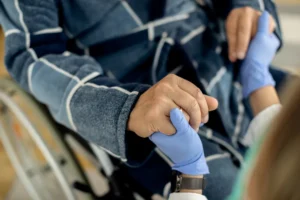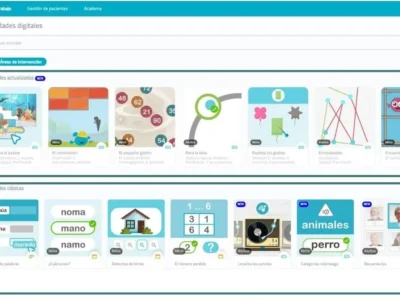In this article, we analyze the main differences between multiple sclerosis and amyotrophic lateral sclerosis, while exploring how the ALS Law affects the treatment and rehabilitation services for patients with ALS.
Neurodegenerative diseases, such as multiple sclerosis (MS) and amyotrophic lateral sclerosis (ALS), seriously affect the quality of life of those who suffer from them. Although both conditions have consequences on the nervous system, each presents important differences in their causes, symptoms and treatments. With the recent approval of the ALS Law 2024 in Spain, new opportunities open up to improve care and rehabilitation for those affected by ALS, and this consequently has a significant impact on the field of neurorehabilitation.
MS and ALS, same name, different surname
There is a lot of confusion between multiple sclerosis (MS) and amyotrophic lateral sclerosis (ALS). Much of the population thinks they are the same disease, but they are actually very different, although both are neurodegenerative diseases and are called “sclerosis”. Because of this, we wanted to explain the main differences between MS and ALS.
What causes them?
Multiple sclerosis is an autoimmune disease that is caused by an unknown virus or antigen. In this case, our immune system attacks myelin, which is a substance that surrounds nerve fibers allowing the transmission of nerve impulses at an appropriate speed. Consequently, communication between neurons is impaired and it causes various symptoms that we will describe below.
In amyotrophic lateral sclerosis the nerve cells responsible for voluntary movements in both the brain and the spinal cord are affected. Therefore, this disease affects only the motor system. Its cause is also unknown.
Symptoms of MS and ALS
The most frequent symptoms of multiple sclerosis are visual disturbances, balance problems, speech problems, hand tremor, limb weakness and loss of strength. Cognitive problems such as issues with memory, encoding and retrieval of information also commonly appear. Likewise, emotional problems like anxiety and depression can occur.
On the other hand, as mentioned before, a patient with amyotrophic lateral sclerosis only presents motor symptoms. Voluntary movements will be affected, they will have loss of strength in arms and legs, problems with the articulation of words and difficulty swallowing. It is important to highlight the severity of this disease, since the patient may eventually develop dysfunction of the respiratory muscles, due to which the life expectancy of these patients is 3 to 5 years from diagnosis.
How are they diagnosed?
Multiple sclerosis is not contagious, nor hereditary and cannot be prevented. Having an early diagnosis is essential.
MS diagnosis is carried out through:
- Medical history.
- Neurological examination.
- Evoked potentials.
- Data from cerebrospinal fluid analysis.
- Demyelinating lesions that can be identified through magnetic resonance imaging. Magnetic resonance imaging (MRI) is one of the main tests to diagnose multiple sclerosis. It is a non-invasive technique that consists of capturing very detailed images of the brain and spinal cord.
Thanks to an MRI, the lesions produced in the brain as a result of the immune system’s attack on myelin can be seen. It should also be noted that this test cannot be considered conclusive because not all lesions can be detected by the scanner and because other diseases can produce identical abnormalities.
Amyotrophic lateral sclerosis is difficult to diagnose since its symptomatology is similar to that of other diseases. Diagnosis is made based on the symptoms detected and through an examination, the so-called electromyography. In some cases more tests are required such as cervical or brain MRIs, muscle biopsies, blood tests or a lumbar puncture if doubts persist.
Treatment for the disease
Currently there is no treatment that cures any of these neurodegenerative diseases. However, we can find some drugs that slow their progression and improve their symptoms.
In both cases, treatment consists of drugs that slow the progression of the disease combined with physiotherapy sessions, occupational therapy and speech therapy. In addition, in multiple sclerosis the role of the neuropsychologist is essential to address the cognitive deficits that appear.
How do MS and ALS progress?
In multiple sclerosis, 85% of patients experience conditions characterized by the periodic appearance of relapses and remissions (relapsing multiple sclerosis). However, these relapses affect all types of patients whose symptoms last 24-72 hours and then remit. Often, they even disappear completely, which does not prevent these patients from deteriorating due to each attack. The other 15% of patients present a slower and progressive onset of the disease (primary progressive form).
In contrast, amyotrophic lateral sclerosis always progresses in a progressive manner, although the rate of deterioration can vary from one patient to another.
What is the population affected by multiple sclerosis and amyotrophic lateral sclerosis like?
MS affects young women between 20 and 40 years old to a greater extent, and in the primary progressive form it affects men between 50 and 60 years old more.
On the other hand, ALS affects people between 40 and 70 years old, affecting males at a ratio of 3 to 1.
Below, we bring you several testimonies about the impact of MS.
Esclerosis en la Onda
Esclerosis en la Onda is a radio program created by and for people affected by multiple sclerosis. Do you know what benefits a pet can bring to people with multiple sclerosis?
ALS Law 2024
On October 10, 2024 the ALS Law in Spain was approved, a regulation that seeks to improve the living conditions of people affected by amyotrophic lateral sclerosis (ALS), as well as strengthen their rights to access treatments and care.
This law represents a major step forward in many aspects. Not only is it an advance in terms of public policy, but it will also positively affect professionals working in the health and neurorehabilitation sector, who will now have more resources to provide comprehensive and multidisciplinary treatment to their patients.
Main benefits of the ALS Law 2024 for those affected by sclerosis
Access to advanced treatments
The new law facilitates access for people affected by ALS to advanced, innovative and experimental treatments that until now were out of their reach. These include both therapies already approved and experimental treatments that could make a difference in the disease’s progression.
- Availability of experimental treatments: those affected can access medications and therapies in clinical trial phases that could improve their quality of life or slow the progression of the sclerosis.
- Equitable access to new therapies: it is guaranteed that, regardless of economic situation or place of residence, all people have the same opportunities to benefit from advanced treatments for ALS.
Financial support
Since the economic burden for people affected by ALS can be overwhelming, the law includes financial aids focused on improving the quality of life of those who suffer from the disease and reducing the financial impact on their families.
- Grants for medications: it is made easier for those affected to receive cutting-edge medications with greater public coverage, which helps alleviate the financial burden on families.
- Tax incentives: tax incentives are offered to families of people with ALS in order to reduce expenses related to treatment and daily care.
- Long-term aid funds: with the implementation of the ALS Law a specific fund is also created to ensure the economic sustainability of people affected by the disease and their families. These are governmental aids from which they can benefit to be able to use wheelchairs and other mobility devices, as well as to adapt their homes to their particular needs.
Improvement of home care
The improvement of home care is also impacted by the approval of the ALS Law 2024. From now on, those affected have access to specialized home assistance in the management of neurodegenerative diseases. This includes continuous 24-hour care by professionals such as physiotherapists, occupational therapists, speech therapists and neuropsychologists.
Promotion of research
For its part, the Instituto de Salud Carlos lll constitutes a structure focused exclusively on ALS research with the objective of promoting research, development, innovation and dissemination around this pathology and promoting scientific advances related to it.
Likewise, the ALS Law offers incentives to scientific institutions to promote research on amyotrophic lateral sclerosis (ALS), which could accelerate the development of more effective treatments and improve the living conditions of patients.
National Registry of Neurodegenerative Diseases
With the approval of the ALS Law, the creation of the National Registry of Neurodegenerative Diseases is established in order to collect valuable information related to incidence, prevalence and other aspects related to this neurodegenerative disease.
The collection and access to these data will allow, in the future, a better understanding of the impact of ALS, as well as optimizing the management of care resources for those affected by the disease.
Conclusion
Although multiple sclerosis (MS) and amyotrophic lateral sclerosis (ALS) are neurodegenerative diseases with significant differences in their progression and treatment, the recent approval of the ALS Law 2024 represents a crucial change for people who suffer from ALS.
This law offers improved access to advanced treatments, specialized home care and financial support for patients and their families. It also boosts research into amyotrophic lateral sclerosis and ensures more comprehensive care.
The ALS Law 2024 marks a before and after in the fight against ALS, providing hope and improving the quality of life of those affected.
If you liked this article about the differences between multiple sclerosis and amyotrophic lateral sclerosis and the impact of the ALS Law 2024, you may also be interested in other posts from NeuronUP:
“This article has been translated. Link to the original article in Spanish:”
Diferencias entre la esclerosis múltiple y la esclerosis lateral amiotrófica y el impacto de la Ley ELA 2024







 Social cognition in children and how we work on it with NeuronUP
Social cognition in children and how we work on it with NeuronUP
Leave a Reply